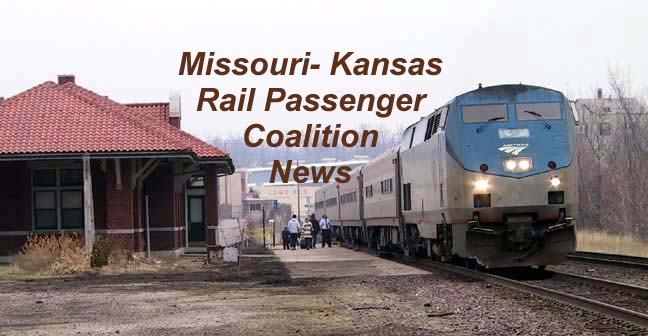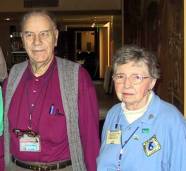 |
Winter 2004P. O. Box
1183 Mission, KS 66202-1183 |
Funding shortfall may mean end to two of the four state-funded trains
Current funding by the
state of Missouri is not enough to continue operation of the state’s four
daily St. Louis – Kansas City trains.
Sharon Dashtaki, Missouri Department of Transportation’s assistant
administrator of railroads, updated MOKSRail members on legislative funding
efforts at MOKSRail’s Oct. 25 meeting at Kansas City Union Station.
She said the state of Missouri approved $5 million for funding Amtrak service.
The amount, however, is $1.1 million short of the $6.1 million Amtrak requires
to run both the Mules and the Anne Rutledge for 12 months. The funding level,
Dashtaki said, only funds the service through Feb. 12, 2004.
“If we don’t receive the additional funding, the Mules will end in February,”
Dashtaki said.
Dashtaki said she’s hopeful a supplemental appropriation will go through. She
said MODOT has been working with en route communities, having them push for
the funding.
The $5 ticket surcharge the Missouri legislature approved has failed, Dashtaki
said, generating only $120,000. “Our recommendation is to
drop that charge,” she said. “For a lot of people, that $5 means a lot to
them, each way. We will lose a lot of passengers that way.”
Passenger counts are down. According to Amtrak, ridership on the Missouri
trains declined 3 % from 2002’s 139,823 passengers to 2003’s 144,201.
However, ridership has increased since July. Dashtaki noted 100 people
disembarked at Hermann on the train she rode in to Kansas City on.
An advance payment experimental program, started in October, will attempt to
reduce the cash fares conductors have to handle on board the trains. Under the
program, the conductor will have the tickets for passengers on board. The
advance payment fares also save passengers money since conductors have to
charge normal fares for on-board purchases, Dashtaki said.
A request for proposals by private operators went out Oct. 15, Dashtaki said.
The state wants to see if another operator can take over the trains’
operation in a more cost-efficient manner. Bids were due Dec. 15.
Herzog Transit Services, of St. Joseph, Mo., publicly announced last spring –
without providing specifics – that it could operate the four daily Missouri
Amtrak trains for a lot smaller price tag. Herzog operates commuter train
systems for transit agencies in Dallas and Miami. Herzog, however, almost as
quickly withdrew its proposal claiming difficulties it said it had gaining
access to Amtrak’s facilities and reservation system.
The state hasn’t had any money for advertising for the past two years, Dashtaki said.
The Missouri Department of
Transportation has increased the Jefferson City Amtrak station space by
one-fourth, said MODOT’s Dashtaki.
“It has been expanded,” she said. “It is now heated and cooled. It’s nicer
now.” Volunteers assist passengers from 9:30 a.m. to 11:30 a.m. and from 4:30
p.m. to 6:30 p.m. Volunteers also greet passengers at the Kirkwood station.
Pete & Carolyn McMasters, long-time officers, announce departure.
Carolyn & Pete McMasters, Roeland Park, Kan., announced their retirement as
secretary and treasurer, respectively, of the grassroots passenger rail
organization at the Oct. 25 MOKSRail meeting. Carolyn & Pete have served as
officers since the late 1980s. They have been instrumental in membership,
meeting organization, lobbying and other MOKSRail efforts throughout the
history of the group.
“They are the heart of our organization,” said
MOKSRail president John Mills, Topeka, Kan. “It’s hard to deny their influence
on this group.”
The
couple plans to remain active as MOKSRail members. The two announced their
retirement primarily because of Pete’s declining health.
“Some of our more vivid memories include going
down to the old Amtrak station early in the morning and ‘leafleting’ the Anne
Rutledge before it left for St. Louis,” said Carolyn. “We did this two or
three times when the train was in danger of being cancelled.”
Besides working to save Kansas City Union
Station, the two cited their greatest effort as getting Amtrak to return to
the station in December 2002.
“It has made a marked difference in the number
of passengers and the attitude of the traveling public in this area,” she
said.<Mills said the McMasters’ did more than anyone else
in the return to KCUS.
Pete McMasters has
documented 156,000 miles on Amtrak since he and Carolyn started traveling
regularly in 1980. The two volunteered at Kansas City Union Station beginning
with the 1986 bi-state campaign and have racked up more than 2,000 hours each
of volunteer service at the station since. They received an Amtrak/Union
Station award during the Amtrak station reopening.
Mills also listed institution of through Kansas
City-St. Louis –New Orleans service, terminated during a budget crisis, as
another MOKSRail accomplishment.
Past MOKSRail president Wayne Copple, Kansas
City, Mo., said since the group’s founding, the McMasters’ and MOKSRail
members have been battling ongoing budget crises.
“The original crisis was in 1979 when we lost
two of our four long-distance trains, the National Limited (New
York–Kansas City) and the Lone Star (Chicago-Kansas City-
Houston),” he said.
“The details have changed, but it’s
the same: lots of money for other transportation but not for rail.”
 |
Pictured: Pete & Caroline McMasters. |
In 2002, MOKSRail
provided money to the Missouri Rail Passenger Advisory Committee, Jefferson
City, for advertising the Missouri train service in the smaller en-route
cities of Hermann, Washington, Sedalia and Warrensburg.
MOKSRail in 2003 helped fund an electric cart
that transports disabled passengers to and from the waiting room area down the
long walk to the elevator that takes passengers to trains in the new Amtrak
station inside Kansas City Union Station.
“Rather than just an
organization in name, we’ve accomplished a lot,” said Mills.
With the
McMasters’ departure, Wayne Sangster, Prairie Village, Kan.,
volunteered to serve as MOKSRail secretary. John Wegner will
serve as temporary treasurer. Mills will remain for this year as
president while Doug Ohlemeier,
Independence, Mo., will continue as vice president, Webmaster and
newsletter editor. Copple volunteered to serve as head of the MOKSRail
reorganization committee.
Election of officers will occur at a future meeting.
continued on following page.
MOKSRail membership…continued from previous page:
The treasurer’s duties
include organizing membership and renewal notices, paying group bills and
balancing the group’s bank account. The secretary and treasurer work closely
together.
In 1989, MOKSRail had 291 paid members. In 1993, 240; in 2002,
154. In October 2003, the group had 104. Only 63 that had
renewed their memberships for 2004, the McMasters’ reported at the October
MOKSRail meeting
Thanks to your letters, faxes and calls to your elected representatives, a House and Senate conference committee Nov. 13 agreed to $1.225 billion for Amtrak; $760 million is for operations and $465 million is for capital.
The final amount is somewhat
less than what the Senate approved in late October, $1.346 billion, but far
better than the $900 million approved by the House and supported by the Bush
Administration, which Amtrak CEO David Gunn called a shutdown budget. The
compromise is less than the $1.812 billion Amtrak had requested ($768 million
for operations and $1.044 billion for capital).
The final operating figure is close to Amtrak's request, according to the
National Association of Railroad Passengers, and the situation is helped by
Amtrak's ability to carry over $200 million in working capital from fiscal
2003. A news report stated that
While Amtrak, under President Gunn, has operated "more businesslike" with
Congress' encouragement, "the existence of that working capital allowed the
conference committee to cut more from the Senate proposal than it otherwise
might have.”
Gunn stated that the funding would allow Amtrak to continue to operate the
national system. Still, Amtrak will have to assess its impact on its current
budget. Many capital items may be pushed into 2005. According to NARP, the
funding process for that year will start soon and the Bush Administration
likely is already considering its own proposal. NARP says it will be
interesting to see if the administration again proposes a funding cut.
According to NARP, the agreement allows for deferral for another year of the
$100-million DOT 2002 loan. Terms of the loan that prevent Amtrak planning new
services continue.
At more than 24 million
passengers for 2002-03, Amtrak reported its highest ever ridership. Ridership
topped its previous record of 23.5 million passengers set in 2001 and was 2.7%
better than last year's 23.4 million.
Long-distance trains showed
substantial improvement over 2002, with those in the Eastern region of the
country improving ridership by 3.8% and those in Western region improving
by 6.6%. Long-distance trains overall increased ridership by 5%. For the
November 2002 to November 2003 period, long-distance ridership increased 32.8%.
Amtrak attributed the increases to "back-to-basics" initiatives, such as fare
cuts. The Texas Eagle increased
20%, the Southwest Chief, 7%.
Amtrak
called the Texas Eagle the catalyst for the record-breaking
numbers. Eagle ridership jumped 45.1% or 19,064 riders in November 2003 versus
13,135 riders in November 2002.
As the year progressed, ridership improved with September long-distance
ridership up 22%. On the Southwest Chief, ridership
grew 36%. The Sunset Limited saw a 34%
increase. September ridership on short distance trains was up 10%.
Oklahoma's Heartland Flyer, which runs from Oklahoma City
to Fort Worth, saw an 11% decline for the fiscal year.
October 2003 ridership, however, increased 51% over October 2002.
The news about the Eagle’s success is especially interesting since the train was
targeted for discontinuance under former Amtrak CEO Tom Downs. The cancellation
was recommended by the Mercer report. That report, however, also recommended and
led to the discontinuance of two other important trains – the Pioneer
(Chicago-Denver-Boise-Portland-Seattle) and the Desert Wind
(Chicago-Denver-Salt Lake City-Las Vegas-Los Angeles).
The Heartland Flyer increased its speed limit from 60 to 79 miles per hour on certain segments of the BNSF between Oklahoma City and Gainesville, Texas. Investment in grade-crossing equipment by the Oklahoma DOT funded the improvements.
The New Mexico legislature, with pushing from the governor, has approved a $6 million commuter rail project from Bernalillo, N.M, on the northern side of the Albuquerque metropolitan area, to Belen, N.M., on the south side. The project would use existing BNSF tracks. The line will be the first section of eventual Santa Fe service. New Mexico’s DOT secretary said she would meet with Amtrak to discuss a demonstration service to run between Albuquerque and El Paso this summer.
Rail and bus transit in the most congested U.S. cities saved drivers more than one billion hours in travel time in 2001, according to the Texas Transportation Institute’s yearly Urban Mobility Report. Without such transit services, delays nationwide would have increased by almost 30%, costing major urban area residents an additional $21.2 billion in lost time and fuel. The American Public Transportation Association said the study shows a strong case for continued investment in transit.
If you have Internet access, please elect to receive newsletters via email.
To save time, copying and mailing costs, MOKSRail plans to distribute future newsletters via email.Those who do not have Internet access will continue to receive the newsletter via regular mail. Pete and Carolyn McMasters, who used to handle the newsletter copying, envelope stuffing, labeling and mailing, stated the process required at least six hours of their time.